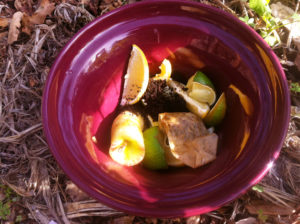Oro negro! declared the late Pedro Hernandez as he dug the compost each winter. Black gold! Pedro was from Guatemala and gardened fourteen years for my dear English landlady. My sister, who lives in Hawaii, likes to tell me about showing her house to guests; her tours always include her compost full of worms. Certain that they find this odd, she does it anyway, sharing her love of transforming old vegetables, fruits, and grass clippings into fine loose soil.
It’s organic. It will go into the earth said our mother, allowing my sister and me to throw apple cores out the car window (do not do this now, you could be arrested!). I experienced my first compost as a child, living in rural Colorado. Since then I have lived in many places—town and country—and nearly always had a compost; I cannot bear to throw out good kitchen scraps. Sometimes, quietly, I bring scraps home if a compost is unavailable.
My sister and I make an uneasy peace with uneaten food knowing it will make happy plants and worms. We also monitor our purchases as best we can, not always an easy task when plans change or we buy more than we can eat.
Food waste is a big problem in America as NPR reported last fall. Statistics indicate that we waste 40 percent of our food. In Marin, over 25% of our landfill waste is food. Recently I learned that organic matter in landfills is a source of global warming creating at least two greenhouse gases, methane and carbon dioxide (CO2). Methane is particularly harmful, 20 times more potent than carbon dioxide. Composting greatly reduces methane production. Additionally it holds onto the carbon dioxide it creates, making it available for plants to use. Pretty cool!
Composting not only creates less waste, greenhouse emissions, but better health with oro negro for our farms and gardens. According to Marin Sanitary Services (MSS), 20% of Fairfax residents use their green bins for food waste and 47% use them for yard waste. What do you do?
Composting Tips: Composting is an art and a science; there are many ways to do it. The tips here are simple. To get a deeper knowledge of this art sign up for Sustainable Fairfax’s newsletter and learn about upcoming composting and worm bin workshops.
First. You will need to set up a system for transferring your kitchen waste to your green bin. There are many types of containers available commercially (see photos). Or be creative like my friend Leanne who uses an etched glass cookie jar.
Second. Decide whether you want to compost at home or let Marin Sanitary do it for you. In either case, collect your food scraps!
Keep it at home. Designate a spot in your yard for your compost—even a simple pile works. Empty your container and use a shovel to lightly cover the fresh scraps with a bit of dirt, grass, wood ash, woodchips, or straw. To aerate your pile, turn it occasionally. Or dig your scraps directly into the earth as my friend does in the narrow garden bed edging his small bungalow. That’s it! Negro Oro!
For a more contained pile, purchase an enclosed compost bin; there are many types available. Or make a cylinder of chicken wire, as small or big as suits your space (see photos). Watch it become crumbly dark soil and use it to top dress your plants.
Or send it away via your MSS green bin to their composting facility in Zamora, Yolo County. Using current technology and constant monitoring they make a good hot compost, between 140º-170º. The resulting compost is distributed to farmers. Each year, several free deliveries are made to Fairfax residents (see Sustainable Fairfax’s calendar for delivery dates).
You can put all your food scraps, vegetable and animal, plus food soiled paper bags, napkins, and towels in the green bin. High heat composts kill pathogens, transforming animal products into soil. Do not put animal scraps into your home compost. Follow this link to learn what goes in your green waste bin. Please note that you cannot put compostable bio-plastics in the green bin—at least not yet!
Keep your green bin clean by putting food scraps in a paper bag before you dump them. Or line the bottom with yard trimmings, newspaper, or paper bags. Like my grandmother Grace, I freeze any animal and dairy scraps before putting them in the green bin just before pick-up. This cuts down on smells and fools the critters.
See Deborah Koons Garcia’s documentary, Symphony of the Soil. It will inspire you!
Please comment on your own composting tips and questions.
Have fun and feed the worms!
